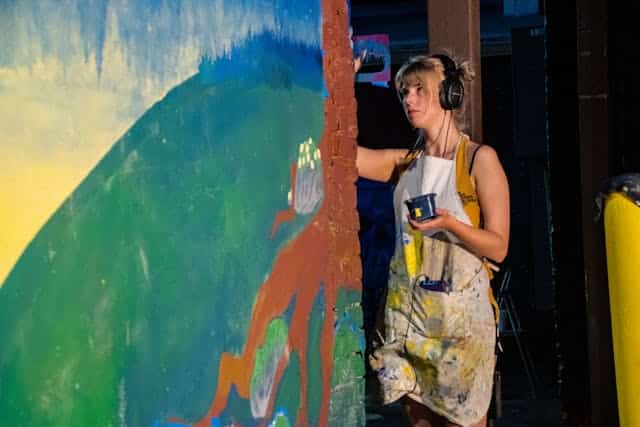Alyson H. Belcourt is an acclaimed contemporary artist known for her captivating and thought-provoking works of art. Her creations reflect both her personal experiences and her cultural heritage, making her a significant figure in the world of modern art. This article explores her artistic journey, techniques, themes, and the impact of her work on the art world. We’ll delve deep into the meanings behind her pieces, her distinctive style, and the significance of Alyson H. Belcourt’s Art in the contemporary art scene.
Who is Alyson H. Belcourt?
Alyson H. Belcourt is a First Nations artist who hails from the Métis community in Canada. As a visual artist, she brings a unique perspective to the art world, combining her Indigenous roots with modern techniques. Alyson’s work reflects her deep connection to her cultural heritage and explores themes of identity, place, and belonging. Her art serves as a powerful platform for telling stories, preserving history, and addressing contemporary issues faced by Indigenous peoples.
Belcourt’s work spans various mediums, including painting, drawing, and installation art. Through her innovative and expressive use of colour, texture, and form, she has captivated audiences worldwide. Her artistic voice is a blend of tradition and modernity, offering a fresh perspective on contemporary Indigenous art.
The Artistic Style of Alyson H. Belcourt
Vibrant and Bold Colors
One of the most defining features of Alyson H. Belcourt’s Art is her use of vibrant, bold colours. She masterfully incorporates rich, earthy tones and striking contrasts into her works, drawing the viewer’s attention and evoking powerful emotions. The colours in her art often symbolize various elements of nature and spirituality, further connecting her works to her Indigenous roots.
Exploration of Identity and Cultural Heritage
Belcourt’s art is deeply rooted in the exploration of identity. As an Indigenous artist, she seeks to portray the complexities of her culture, community, and personal history. Through her art, she reflects on the effects of colonization, the ongoing struggle for cultural preservation, and the importance of maintaining a connection to the land.
Her work is also a celebration of her Métis heritage, embracing the fusion of various cultures and perspectives. This exploration of identity is not just personal but also political, as she highlights the importance of Indigenous voices in today’s society.
Use of Abstract Forms and Symbolism
Another hallmark of Alyson H. Belcourt’s work is her use of abstraction and symbolism. Her paintings often contain abstract forms that serve as metaphors for personal and collective experiences. These abstract elements are used to represent cultural symbols, spiritual beliefs, and environmental issues. This approach allows her to convey complex messages and emotions in a visual language that transcends words.
A Focus on Nature and the Environment
Nature plays a significant role in Belcourt’s artwork. The natural world is often a central theme, with her pieces depicting landscapes, animals, and elements of the environment. Her work reflects a deep reverence for nature and a recognition of the critical relationship between Indigenous peoples and the land. These themes often resonate with audiences, highlighting the need for environmental conservation and respect for the earth.
Themes in Alyson H. Belcourt’s Art
The Interplay Between Tradition and Modernity
One of the recurring themes in Alyson H. Belcourt’s art is the intersection of traditional Indigenous knowledge and modern artistic expression. By blending ancient cultural practices with contemporary techniques, she creates a bridge between the past and the present. This fusion allows her to address the ongoing conversation about the preservation of Indigenous culture and the challenges of adapting to a rapidly changing world.
Colonialism and Its Impact
Belcourt’s art also deals with the enduring effects of colonialism on Indigenous communities. She uses her work to comment on the historical and contemporary struggles faced by Indigenous peoples. Her pieces often serve as both a reflection of pain and a call to action for healing and reconciliation.
Resilience and Empowerment
Despite the themes of loss and struggle, Alyson H. Belcourt’s art is also about resilience and empowerment. Her work showcases the strength of Indigenous communities and their ability to persevere in the face of adversity. Through her art, she encourages the viewer to acknowledge the importance of cultural survival and empowerment.
Alyson H. Belcourt’s Artistic Process
Conceptualization
The creative process for Alyson H. Belcourt begins with a deep conceptualization phase. Before starting a piece, she carefully considers the themes, messages, and cultural significance she wants to communicate. This thoughtful approach ensures that her art is not only visually striking but also rich in meaning.
Medium and Technique
Alyson is versatile in her choice of mediums. She has worked with various materials, from acrylic paints to natural pigments and even textiles. Her use of mixed media allows her to create texture and depth in her works. By combining different techniques, she creates unique pieces that engage the viewer in multiple ways.
Storytelling Through Art
Storytelling is at the heart of Alyson H. Belcourt’s practice. Her works often tell stories of personal experiences, family history, or cultural traditions. The visual elements in her art serve as a language that communicates her stories to the viewer. By integrating personal narratives into her artwork, she offers a more intimate and authentic experience for those who engage with her work.
Impact and Recognition
Alyson H. Belcourt’s art has been widely recognized in both the Indigenous and broader art communities. Her work has been displayed in galleries and museums across Canada and internationally, allowing her to reach a global audience. Through her exhibitions and public installations, she has helped raise awareness of Indigenous art and culture.
Her contributions to the art world have earned her various accolades, and she continues to be a source of inspiration for emerging Indigenous artists. Belcourt’s work has not only been appreciated for its aesthetic beauty but also for its ability to provoke critical thought and discussion around Indigenous rights, identity, and the environment.
Conclusion
Alyson H. Belcourt’s art is a powerful representation of her Indigenous heritage, addressing complex themes of identity, colonialism, resilience, and the environment. Through her innovative use of colour, symbolism, and abstraction, she has created a distinctive artistic voice that resonates with audiences worldwide. As a contemporary Indigenous artist, she continues to challenge conventional norms and break boundaries, making a lasting impact on the art world. Alyson H. Belcourt’s Art is a testament to the strength and endurance of Indigenous cultures, and her work is sure to inspire future generations of artists and art lovers alike.
Frequently Asked Questions
What is Alyson H. Belcourt known for?
Alyson H. Belcourt is known for her vibrant and thought-provoking contemporary art that explores themes of Indigenous identity, culture, and the environment.
What mediums does Alyson H. Belcourt use in her art?
Alyson H. Belcourt uses a variety of mediums, including acrylic paints, natural pigments, textiles, and mixed media, to create texture and depth in her works.
How does Alyson H. Belcourt address colonialism in her art?
Belcourt addresses colonialism through her art by highlighting its ongoing effects on Indigenous communities and by using her work as a platform for reflection and social change.
Where has Alyson H. Belcourt’s art been displayed?
Her art has been exhibited in galleries and museums across Canada and internationally, showcasing her contributions to contemporary Indigenous art.
What is the significance of Alyson H. Belcourt’s work in the art world?
Belcourt’s work is significant because it not only celebrates Indigenous culture but also provokes thought about identity, cultural survival, and the challenges of modern-day Indigenous communities.







